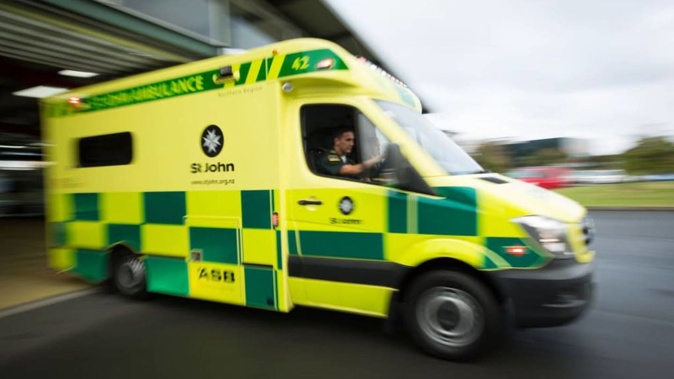
By Ruth Hill of RNZ
The equivalent of nine ambulances a day are unable to respond to callouts because they are stuck outside emergency departments, waiting to drop off patients.
Figures provided to RNZ by Hato Hone St John Ambulance show “ramping” - the extra time crews spend waiting for patients to be admitted - has increased more than threefold nationwide since 2019.
The service allows 30 minutes for a crew to hand over a patient to hospital staff, complete documentation, restock and debrief. Any minute over that counts as ramping.
In the first three months of this year, those extra minutes added up to 10,249 hours - or 427 days. In the same period in 2019, the figure was about 3300 hours.
New Zealand Ambulance Association national secretary Mark Quin said only five or six years ago, it took 15 minutes on average to transfer a patient.
“That’s just unrealistic now. I spent two and a half hours sitting at the emergency department with a patient recently because they just had no room.”
Quin, a Palmerston North paramedic, said overflowing hospitals were “effectively using ambulances as extra wards”.
“So now we’re stacking [patients] around the corridors and creating makeshift rooms, which are basically a number on the wall with a stretcher parked next to it.”
St John ambulance manager Stuart Cockburn said the extra ramping time had resulted in a reduction, on average, of nine ambulance shifts a day.
“It’s certainly not ideal. We’re working really hard with our partners at Te Whatu Ora to minimise the times that this occurs and the frequency. Unfortunately, it’s an international problem.”
The length of time ambulances are waiting at emergency departments when dropping off patients at 15 hospitals, April 2022 to March 2023. Data source / St John
If it looked like wait times were starting to ramp up, St John alerted hospitals to get in extra staff, he said.
“If they can’t, or if they can only provide one person for example, then we will use one of our ambulance crews to look after three or four patients at a time.”
St John has identified 15 hospitals nationwide where ramping is a problem.
The average transfer time over the year to March 2023 was 33 minutes, but some were taking much longer.
Hutt Hospital Emergency doctor Tanya Wilton said the pile-up means patients were waiting longer for an ambulance at home.
“The backlog of being able to provide good care and timely care for patients that is a huge problem and again that adds complexity and complications for patients to recover when they’ve had long waits, people lying for a long-time on the floor waiting for an ambulance to come,” Wilton said.
She feared it was a problem that had been growing for many years.
“For example in a hospital, you’ve got beds that are filled, so high hospital occupancy and it means it’s then difficult to move patients from the emergency department into hospital beds and some of that is a factor of staffing as well. So while there might be physical beds available in the hospital there’s an inability to provide nursing and other care for patients so some of those other beds are unable to be utilised,” Wilton said.
She said another consequence of ambulance ramping was loss of face-to-face communication.
“I used to see a lot more of the paramedics and I would get a handover from them directly whereas now I’m often tied up and they’re out in another area of the department transferring their patients over.”
At Auckland City Hospital, ramping increased nearly 600 per cent since 2019 and at Waikato it was up more than 680 per cent.
Australasian College for Emergency Medicine New Zealand chairwoman Kate Allan said ramping was a symptom of the pressure on the whole health system.
To cure ambulance ramping and ED overcrowding, New Zealand needed more staffed hospital beds, more mental health beds, more aged-care beds - more of everything, she said.
“This will then free up hospital beds for those patients stranded in the emergency department waiting for one, and help get ambulances back on the road faster, too.”
Staff shortages
St John had about 150 vacancies nationwide, around 8 per cent of its workforce.
It was recruiting internationally and also training its own Emergency Medical Technicians (EMTs) - clinically qualified ambulance personnel - through intensive six-month courses.
However, Quin said more needed to be done to retain existing staff.
“I know three of my colleagues on the same station have gone over to northern Australia to work for better pay.”
Delays were inevitably hurting patients.
“If we can’t get this right, we will watch deaths occurring out in the community that didn’t need to happen.”
Te Whatu Ora national director of hospital and specialist services Fionnagh Dougan said the pressure on the wider health system made it difficult to free up space in hospitals.
“Despite the very best efforts of our fantastic hospital teams, we acknowledge that ambulance teams are sometimes waiting longer than we would like to hand patients over.
“While patients remain safe in the care of St John, the handover delay affects their ability to be back out responding to our communities, where we all want them to be.
“Ensuring patients get the care they need, at the right time, at the right place, is a priority for our organisations.”
Te Whatu Ora and Hato Hone St John have set up a joint working group to reduce ramping with several programmes to ease pressure over the busy winter months.
“This includes looking at how we escalate issues quickly, supporting patients to receive care outside of the hospital environment and establish more flexible workforces.”
- RNZ
Take your Radio, Podcasts and Music with you

/cloudfront-ap-southeast-2.images.arcpublishing.com/nzme/NH3R64MW5VGOLDOJWUFEKPIXNY.JPG)








